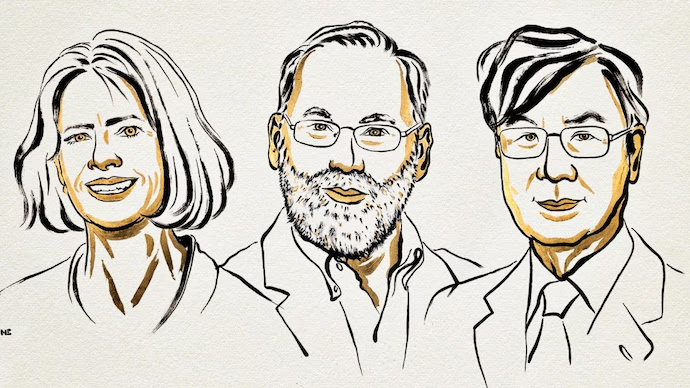🏆 Laureates
Awarded to:
Mary E. Brunkow – Institute for Systems Biology, Seattle (USA)
Fred Ramsdell – Sonoma Biotherapeutics, San Francisco (USA)
Shimon Sakaguchi – Osaka University, Osaka (Japan)
Prize Citation:
“For their discoveries concerning peripheral immune tolerance.”
🧠 1. Context — Why This Discovery Matters
The immune system defends the body against infections. However, it must also avoid attacking the body’s own cells.
If this regulation fails, autoimmune diseases occur — such as Type 1 diabetes, multiple sclerosis, or lupus.
The 2025 Nobel laureates discovered how the immune system keeps itself in check — through a mechanism known as peripheral immune tolerance, which involves regulatory T cells (Tregs).
🧩 2. Key Concept: Immune Tolerance
The immune system distinguishes between “self” and “non-self” through two mechanisms:
| Type | Location | Function |
|---|---|---|
| Central Tolerance | Thymus (during T cell development) | Eliminates self-reactive immune cells. |
| Peripheral Tolerance | Outside thymus (in body tissues) | Controls any self-reactive immune cells that escape elimination. |
Peripheral tolerance acts as a second layer of protection, ensuring that escaped immune cells do not attack the body.
🔬 3. The Nobel Discoveries — Chronological Summary
(a) Shimon Sakaguchi’s Discovery (1995)
Discovered a new class of immune cells called Regulatory T Cells (Tregs).
These cells suppress the activity of self-reactive immune cells.
This was a revolutionary idea — until then, scientists believed immune tolerance occurred only in the thymus (central tolerance).
(b) Mary Brunkow & Fred Ramsdell’s Discovery (2001)
Studied a mouse strain prone to autoimmune diseases.
Discovered a mutation in a gene named Foxp3.
Found that this gene is essential for immune regulation.
In humans, Foxp3 mutations cause a rare autoimmune disease called IPEX (Immune dysregulation, Polyendocrinopathy, Enteropathy, X-linked).
(c) The Link Between the Discoveries (2003)
Sakaguchi later proved that the Foxp3 gene controls the development of Regulatory T Cells (Tregs).
This connection established that Foxp3 is the master regulator of immune tolerance.
⚙️ 4. Core Mechanism — How Peripheral Immune Tolerance Works
Regulatory T Cells (Tregs) monitor and suppress overactive immune cells.
Foxp3 gene directs the development and function of these Tregs.
This process prevents autoimmunity by ensuring the immune system does not attack self-tissues.
💡 Analogy:
Think of Tregs as the “police officers” of the immune system — ensuring that soldiers (immune cells) do not attack friendly citizens (our own cells).
💉 5. Medical & Scientific Impact
a. Understanding Autoimmune Diseases
Provided the molecular explanation of diseases like:
Type 1 Diabetes
Multiple Sclerosis
Lupus
Rheumatoid Arthritis
IPEX Syndrome
b. Therapeutic Applications
Opened avenues for:
Autoimmune therapy (by enhancing Tregs)
Cancer immunotherapy (by temporarily reducing Tregs to allow immune attack on tumors)
Transplant tolerance (to reduce organ rejection)
c. Clinical Trials
Several Treg-based therapies are under clinical trials globally.
📘 6. UPSC Relevance
(i) Prelims Pointers
Year: 2025 Nobel Prize in Medicine
Topic: Peripheral Immune Tolerance
Key Terms: Regulatory T Cells, Foxp3 gene, Autoimmunity, IPEX syndrome
Scientist Names: Mary E. Brunkow, Fred Ramsdell, Shimon Sakaguchi
(ii) Mains Relevance
GS Paper III – Science & Tech
Application of biotechnology in human health.
Immune system and disease management.
GS Paper II – Health & Ethics
Ethical aspects of gene manipulation and immunotherapy.
Essay Paper
Themes like “Science and Human Well-being” or “Frontiers in Medical Research”.
🔑 7. Key Takeaways (For Quick Revision)
| Concept | Key Point |
|---|---|
| Peripheral Tolerance | Prevents immune cells from attacking self-tissues. |
| Regulatory T Cells (Tregs) | Control overactive immune cells. |
| Foxp3 Gene | Governs the development of Tregs. |
| Autoimmune Disease | When tolerance fails, immune system attacks self. |
| Clinical Application | Treatment of autoimmune disorders, cancer, and organ rejection. |
🧭 8. Broader Implications
Encourages the development of precision immunotherapy.
Strengthens the field of translational medicine — linking lab research to clinical use.
Deepens understanding of immune homeostasis, critical for vaccine and drug design.
🧩 9. UPSC Value Addition
Linkages to Indian Context:
India’s focus on biomedical research and immunology under DBT & ICMR.
Possible integration in National Mission on Biotechnology.
Relevance to Ayushman Bharat’s preventive healthcare focus.
🧠 10. Conclusion
The 2025 Nobel Prize in Medicine recognizes discoveries that revolutionized our understanding of the immune system.
By identifying Regulatory T Cells and the Foxp3 gene, the laureates uncovered the molecular safeguards that prevent our bodies from self-destruction.
Their work not only advances immunology but also opens new pathways for treating autoimmune diseases, cancer, and organ rejection — marking a new era of immune regulation-based medicine.
🔗 For UPSC IAS 2026 Preparation
To stay updated with Nobel-level scientific breakthroughs and exam-relevant analysis, visit Victor Growth — India’s trusted learning platform for UPSC IAS 2026 preparation, offering expert-curated current affairs, conceptual clarity, and detailed analysis for all GS papers.







